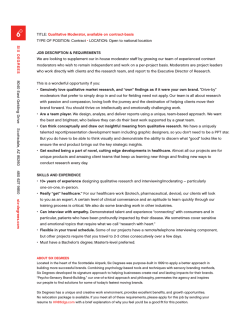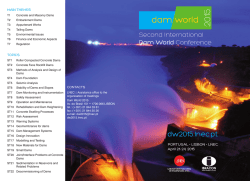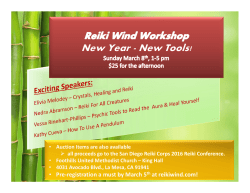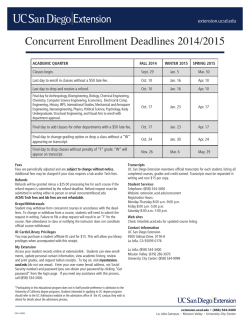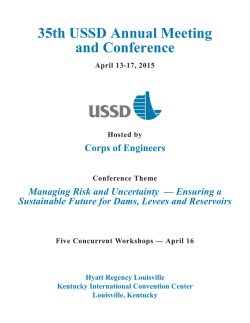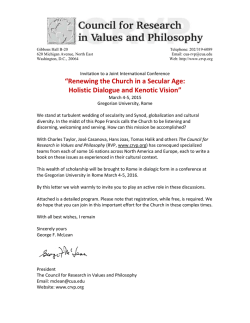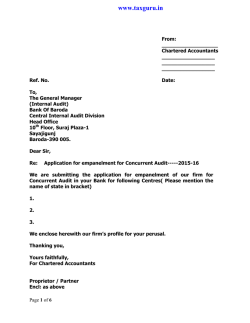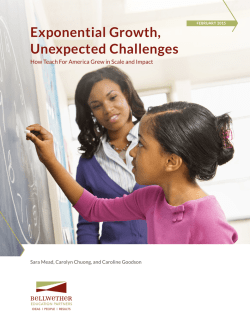
35th USSD Annual Meeting and Conference Managing Risk and
35th USSD Annual Meeting and Conference Managing Risk and Uncertainty — Ensuring a Sustainable Future for Dams, Levees and Reservoirs Monday, April 13 7:00 a.m. - 6:00 p.m. 10:00 a.m. - 5:00 p.m. 5:00 p.m. - 6:30 p.m. 10:00 a.m. - 12:00 noon Registration Committee Meetings 2015 Annual Meeting of Members and updates from related organizations Opening Plenary Session (continued) Moderator — B. Alex Grenoble, HDR CHINCOLD Introduction Michael F. Rogers, MWH Safety Assessment on the Heightening Project of Danjiangkou Dam Li Songhui, China Institute of Water Resources and Hydropower Research Presiding — USSD President Keith A. Ferguson, HDR 6:30 p.m. - 8:30 p.m. Kick-off Reception/Exhibition Opening Tuesday, April 14 7:00 a.m. - 6:00 p.m. 7:00 a.m. - 8:00 a.m. 8:00 a.m. - 9:30 a.m. Registration Continental Breakfast in Exhibit Hall Opening Plenary Session Benefits of Collaboration in Reservoir Planning and Permitting — Balancing Environmental Impacts Against the Need for Sustainable Reservoirs Bob Sinkler, The Nature Conservancy Sustainable Water Supply and Climate Change George W. Annandale, Golder Associates Inc. Mineral Extraction – Potential Impacts to Dams and Levees Steve Brewster, Corps of Engineers Moderator — Keith A. Ferguson Welcome and Introductions Keith A. Ferguson Welcome to Louisville representative, city of Louisville Corps of Engineers Welcome Col. Christopher G. Beck, Commander, Louisville District Overview of Risk and Uncertainty Gregory B. Baecher, University of Maryland Risk and Uncertainty — What Implementation Entails for Decision Makers James Dalton, Chief of Engineering and Construction, Corps of Engineers 9:30 a.m. - 10:00 a.m Break in Exhibit Hall 12:00 noon - 1:15 p.m. Lunch with Speaker in Exhibit Hall Moderator — Keith A. Ferguson 7 Lessons in Risk Policy Implementation — Things We Can Learn from Enterprise Risk Management and Alice in Wonderland Elena Sossenkina, HDR 1:30 p.m. - 3:00 p.m. Examining Three-Dimensional Effects of Internal Erosion (IE) and Piping Processes in Soil Scott Anderson and Keith Ferguson, HDR Engineering, Inc. Concurrent Session 1A — Managing Risk and Uncertainty Moderators — Brian Becker, Bureau of Reclamation; and Jesse Kropelnicki, Parsons Brinckerhoff Evaluation of Impact of Density on Filtering Properties of Narrow Vertical Filters Edwin R. Friend, RJH Consultants, Inc., Kerry Repola, Advanced Terra Testing; Robert J. Huzjak, RJH Consultants, Inc.; and Chris Wienecke, Advanced Terra Testing Lessons Learned from Reclamation’s Two Decades of Risk Assessment Experience William Engemoen, Daniel Osmun and William Fiedler, Bureau of Reclamation 1:30 p.m. - 3:00 p.m. Dam Safety Portfolio Risk Management: Private Sector vs. Government George A. Kelley, Tennessee Valley Authority; David B. Paul, Corps of Engineers; Marty McCann, Jack R. Benjamin and Associates; and Robert C. Bachus and Glenn J. Rix, Geosyntec Consultants Moderators — Donald H. Babbitt, Consultant; and Joseph L. Ehasz, URS Corporation Known and Unknown Damping in FLAC Program Mohsen Beikae and Chris Hill, Metropolitan Water District of Southern California The FERC RIDM . . . What's in it for Me? Guy S. Lund, URS Corporation; and Bill Christman and Gene Yow, Chelan County Public Utility District 1:30 p.m. - 3:00 p.m. Pragmatic Design of an Embankment Dam: Bury Deadmen and Forget About It (Forgetaboutit) Michael S. Quinn and Gary Dale, CHA, Consulting, Inc. Concurrent Session 1B — Construction I Moderators — William Christman, Chelan County Public Utility District; and Daniel L. Johnson, Tetra Tech Generalized Scaling Principles for Physical Modeling of Embankment Dams in Evaluation of Seismic Behavior Nam-Ryong Kim and Jeong-Yeul Lim, K-water Institute; and Ik-Soo Ha, Kyungnam University Design and Construction of a Secant-Pile Cutoff Wall in Variable Ground Conditions Erik Newman and Michael Forrest, URS Corporation; and Kylan Kegel and Kenneth Pattermann, Corps of Engineers 1:30 p.m. - 3:00 p.m. Hybrid TRD and Jet Grout Cutoff Wall at Lake Manatee Dam James D. Hussin, Glen R. Andersen, Dennis Boehm and Curtis Cook, Hayward Baker Inc. Concurrent Session 1E — Hydrology and Hydraulics I Moderators — Denise Bunte-Bisnett, Santee Cooper; and Laura Ann LaRiviere, Consultant Lessons Learned from the Bluestone Dam Inflow Design Flood Update D. Moses, N. Koutsunis, K. Halstead and D. Margo, Corps of Engineers Double Row Grout Curtain Design and Construction for Cedar Creek Dam in Malakoff, Texas Daniel P. Bole, Hayward Baker Inc.; and Marc T. Miller, Freese & Nichols Inc. 1:30 p.m.- 3:00 p.m. Concurrent Session 1D — Seismic Hydraulic Modeling for Coastal Dams Chad W. Cox, Kristina Ekholm and Bin Wang, GZA GeoEnvironmental Inc. Concurrent Session 1C — Embankment Dams Hydrologic Investigation for Saddleback Flood Retarding Structure Bert Clemmens and Suzanne Monk, WEST Consultants, Inc.; Stephanie Gerlach, Flood Control District of Maricopa County; and Chuck Davis, WEST Consultants, Inc. Moderators — Guilaine Roussel, Terra Engineers, Inc.; and Stephen L. Whiteside, CDM Smith Evaluating the Mechanics of Piping Erosion Initiation Through Laboratory Modeling Richard Keizer, GEI Consultants, Inc.; and John Rice, Utah State University 3:00 p.m. - 3:30 p.m. 2 Break in Exhibit Hall 3:30 p.m. - 5:30 p.m. Concurrent Session 2A — Managing Risk and Uncertainty (continued) 3:30 p.m. - 5:00 p.m. Concurrent Session 2C — Embankment Dams (continued) Moderators — Brian Becker and Jesse Kropelnicki Moderators — Guilaine Roussel and Stephen L. Whiteside Risk Prioritization and Mitigation Evaluation for a Portfolio of Dams in Kentucky Michelle Meehan and Jonathan Keeling, Stantec Mix Design and Construction of Asphalt Concrete Face Slab in Frozen Region Lu Yihui, Feng Minghui, Xia Shifa, Hao Jutao and Liu Zenghong, China Institute of Water Resources and Hydropower Research The Role of Empiricism in Quantitative Risk Analysis William Engemoen, William Fiedler and Daniel Osmun, Bureau of Reclamation Revisiting the Forgotten Dam Building Technology: Concrete Core Walls in Embankment Dams Richard R. Davidson, URS Corporation; and Kenneth B. Hansen, Consulting Engineer Transitioning to Risk-Informed Design Standards — Corps of Engineers Strategies for Major Revisions to its Design Philosophies Nathan J. Snorteland, Jeffrey A. Schaefer, Scott E. Shewbridge and David A. Margo, Corps of Engineersd Risk Assessment; Balancing Act to Achieve Long-Term Stability for Safety of Aging Dams William J. Friers and Kapila S. Pathirage, CDM Smith; and Chris E. Wheland, Department of Public Utilities, City of Troy, NY Evaluation Tool D-SMART for Risk-Based Dam Safety Management Jeong-Yeul Lim and Nam-Ryong Kim, Korea Water Resources Corporation 3:30 p.m. - 5:30 p.m. 3:30 p.m. - 5:30 p.m. Concurrent Session 2B — Construction I (continued) Concurrent Session 2D — Seismic (continued) Moderators — Donald H. Babbitt and Joseph L. Ehasz Water Delivery After a Large San Andreas Earthquake — An Unconventional Retrofit Approach Michaele Monaghan, Gregory Reichert and Dustin Jolley, AECOM; and Leroy Gullette and Tasso Mavroudis, San Francisco Public Utilities Commission Moderators — William Christman and Daniel L. Johnson Grouting Open Joints in Concrete Intake Structure Michael McCaffrey, Parsons Brinckerhoff; Mark Gross, APGI, Yadkin Division; and Tony Plizga and Florijon Dhimitri, Parsons Brinckerhoff Seismic Risk to Flood-Control Structures and Agriculture in the New Madrid Seismic Zone of Northeast Arkansas and Southeast Missouri Christopher A. King, Natural Resources Conservation Service, USDA Leak Sealing of Underwater Joint on Upstream Face of a Concrete Gravity Dam Kevin Finn, Parsons Brinckerhoff; Jeff Auser and Matthew Johnson, Brookfield Renewable Power; and Paul Shiers and Michael McCaffrey, Parsons Brinckerhoff Analysis of Seismic Deformations and Cracking for Embankments of the Tekapo Canal Lelio H. Mejia, URS Corporation Deep Water at Horse Mesa Dam — Design of Repairs George V. Sabol, Stantec Consulting Services Inc; Roger E. Baker, Salt River Project; and Michael Langen, Global Diving & Salvage, Inc. Dam Failure-Nuclear Plant Seismic PRA Model — Modeling Correlations and Uncertainty Martin W. McCann, Jr., Jack R. Benjamin & Associates, Inc.; Greg Paxson, Schnabel Engineering; and Raymond Schneider and Andrea Maioli, Westinghouse Electric Company, LLC Deep Water Construction at Horse Mesa Dam Michael Langen, Global Diving & Salvage, Inc., George V. Sabol, Stantec Consulting Services Inc; and Roger E. Baker, Salt River Project 3 3:30 p.m. - 5:30 p.m. 5:30 p.m.- 7:30 p.m. Concurrent Session 2E — Hydrology and Hydraulics I (continued) Poster Session, Exhibition and Reception Systems Engineering Analysis of Dam Safety at Operating Facilities G.B. Baecher, University of Maryland; R. Ascila, Vattenfall; D.H.D. Hartford, BC Hydro; A.N-A. Komey, University of Maryland; R.C. Patev, Corps of Engineers; and P.A. Zielinski, OPG Moderators — Denise Bunte-Bisnett and Laura Ann LaRiviere Addressing Operational Risks and Uncertainties for Gated Spillways Greg Paxson, Robert Indri and Mark Landis, Schnabel Engineering, Inc. A Hydrogeologic Investigation at Patoka Dam, Indiana, to Support Dam Safety Risk Assessment Lee Anne Bledsoe and Chris Groves, Western Kentucky University; and Kenneth Henn and Jackie Rowe, Corps of Engineers Debris and Maintenance of Labyrinth Spillways Brian M. Crookston, Schnabel Engineering, Inc.; Dustin Mortensen and Tina Stanard, Freese and Nichols, Inc.; Blake P. Tullis, Utah State University; and Victor M. Vasquez, Freese and Nichols, Inc. Highlights and Challenges of Constructing the Portugues Thick-Arch RCC Dam in Puerto Rico Rafael Ibáñez-de-Aldecoa, David Hernández and Eskil Carlsson, Dragados USA, Inc. Design Approaches and Numerical Modeling of a Stepped Spillway Under High Tailwater Conditions Laura Shearin-Feimster and Brian M. Crookston, Schnabel Engineering, Inc.; and Stefan Felder, University of New South Wales Evaluating the Stability of Internally Deteriorated Levees Gholamreza Saghaee and Mohamed A. Meguid, McGill University Modeling Flooding from a Catastrophic Dike Breach Along Elbe River, Germany June 2013 Robert Jüpner, University of Kaiserslautern; André Assmann, geomer GmbH; Thilo Weichel, State Authority for Flood Protection and Water Management; Bernd Ettmer and Stefan Müller, University of Applied Sciences Magdeburg-Stendal; and Nageshwar Bhaskar, University of Louisville Site Characterization of Dam Infrastructure for Engineering Risk Assessments Using a GIS Meghann Wygonik, Christopher Kelly, William Walker and Baron Worsham, Corps of Engineers 7:30 p.m. - 10:00 p.m. 4 Young Professionals Social Event Wednesday, April 15 8:00 a.m. - 10:00 a.m. 7:00 a.m. - 5:30 p.m. 7:00 a.m. - 8:00 a.m. 8:00 - 10:00 a.m. Moderators — José L. M. Clemente, Bechtel Corporation; and Robert E. Snow, D'Appolonia Engineering Division of Ground Technology, Inc. Registration Continental Breakfast in Exhibit Hall Concurrent Session 3A — Concrete Dams I Evaluation of Mine Breakthrough at Coal Tailings Impoundment Aaron Antell, Erik R. Schuller and Robert M. Shusko, D’Appolonia Engineering Division of Ground Technology, Inc. Moderators — Vic Iso-Ahola, MWH; and Guy S. Lund, URS Corporation State of Practice of Seismic Analysis of Arch Dams Gurinderbir Sooch, Hatch Ltd; and Dan D. Curtis, Hatch Associates Consultants Factors Affecting Upstream Construction at Coal Tailings Impoundments Robert M. Shusko, Aaron J. Antell and Andrew Antell, D’Appolonia Engineering Division of Ground Technology, Inc. Seismic Fragility for Risk Assessment of Concrete Gravity Dams Yusof Ghanaat, Quest Structures, Inc.; and Robert C. Patev and Anjana K. Chudgar, Corps of Engineers Seismic Evaluations for Coal Combustion Residual (CCR) Impoundments Located in the Eastern Seismic Zone Weston Shin, James McNash and Ramachandran Kulasingam, Geosyntec Consultants Evaluating Seismic Induced Hydrodynamic Loads on Spillway Gates Jerzy Salamon, Bureau of Reclamation 8:00 a.m. - 10:00 a.m. Crack Mechanism and Prevention Measures of Concrete in the Initial Pouring Based on Field Temperature Gradient Experiment Liu Youzhi, Zhang Guoxin and Wang Zhenhong, China Institute of Water Resources and Hydropower Research; and Li Renjiang, China Three Gorges Corporation 8:00 a.m. - 10:00 a.m. Concurrent Session 3C — Tailings and Ash Impoundments Concurrent Session 3D — Hydrology and Hydraulics II Moderators — James D. Hussin, Hayward Baker Inc.; and Olga Zabawa, Parsons Brinckerhoff Dam Removal and Restoration Methods: HEC-RAS Modeling of the Former Chambersburg Reservoir Zachary R. Phillips, Shippensburg University Concurrent Session 3B — Levees Moderators — William B. Empson, Corps of Engineers; and Elena Sossenkina, HDR Planning, Design, Cost, and Construction Considerations for a Million Cubic Foot per Second Stilling Basin: Bluestone Dam Case Study Dana W. Moses, Kenneth Halstead and Salvatore Todaro, Corps of Engineers Analysis of Ship Grounding for the New Dams of the Panama Canal Lelio Mejia and Ethan Dawson, URS Corporation; and Arul Arulnathan and Maximiliano De Puy, Panama Canal Authority Development of Hydrologic Hazard Curves Using the Monte Carlo Reservoir Analysis Model (MCRAM) for Herbert Hoover Dike at Lake Okeechobee, FL Haden Smith and Greg Karlovits, Corps of Engineers Modeling Geomorphic Features in Levee Reliability Analyses Lourdes Polanco-Boulware and John Rice, Utah State University Construction Flood Case Histories Daniel D. Mares and David P. Keeney, Bureau of Reclamation Uncertainty of Soil Compressibility in Transient and Unsaturated Seepage Analyses Timothy D. Stark, Navid H. Jafari and Aaron L. Leopold, University of Illinois at Urbana-Champaign Incorporating River Scour into Levee Stability Analyses Jim Nickerson and Justin Dominguez, GEI Consultants, Inc.; Kevin DiRocco, Consultant; Alberto Pujol, GEI Consultants, Inc.; and Ken Langholz, City of Kent, WA 5 8:00 a.m. - 10:00 a.m. 10:30 a.m. - 12:00 noon Concurrent Session 3E — Dam Safety and Security Moderators — Aled Hughes, MWH; and Phoebe Purcell, Bureau of Reclamation Concurrent Session 4B — Levees (continued) Moderators — William B. Empson and Elena Sossenkina When Your Levee Cannot be Accredited ....Then What? Maureen P. Cissel, McCormick Taylor Implementation of New York State’s Guidance for Dam Hazard Classification Kevin Ruswick and Gregory Daviero, Schnabel Engineering Development of Uncertainty Methodologies and Analysis Using Logic Trees for Levee Risk Assessments Robert C. Patev, Corps of Engineers; Javier Ordonez, Palisade Corporation; Gregory B. Baecher, University of Maryland; and Cynthia A. Colquitt, Corps of Engineers From Data Graveyards to Smart Phones: Leveraging Technology to Modernize Dam Hazard Assessments Benjamin Israel-Devadason, Paul G. Schweiger, Kate Aulenbach and Amanda J. Hess, Gannett Fleming, Inc.; and Karen Goff, North Dakota State Water Commission Best Practices for Data Collection During Levee Flood Fights Cory Williams and Noah Vroman, Corps of Engineers Potential Failure Modes for a Natural Dam Including Estimated Duration of Failure Modes David Thompson, MWH Global; Li Yan, BC Hydro; Greg Rollins, MWH Global; and Ken Lum, BC Hydro 10:30 a.m. - 12:00 noon Concurrent Session 4C — Tailings and Ash Impoundments (continued) A Near-Miss When a Historic Rainfall Located the Weak Link in a Recently Upgraded Embankment Dam Daniel L. Johnson, Tetra Tech, Inc.; Ryan D. Schoolmeesters, State of Colorado; and Brad Dallam, City of Lafayette, Colorado Moderators — José L. M. Clemente and Robert E. Snow 10:00 a.m. - 10:30 a.m 10:30 a.m. - 12:00 noon 10:30 a.m. - 12:00 noon Geotechnical Properties and Diagenesis of Ponded Fly Ash Robert C. Bachus, Geosyntec Consultants; and J. Carlos Santamarina, Georgia Institute of Technology Conditions of Coal Ash Embankments John Seymour, Omer Bozok, Amanda Hughes and Brad Bodine, Geosyntec Consultants Break in Exhibit Hall Young Professionals Workshop Concurrent Session 4A — Concrete Dams I (continued) Preservation of Piezometers and Associated Automated Data Acquisition Systems in Tailings Dams Dennis J. Fela and David R. Welters, D'Appolonia Engineering Division of Ground Technology, Inc. Moderators — Vic Iso-Ahola and Guy S. Lund Evaluating Relative Condition of Repeated Structural Elements with Performance-Based Testing Spenser Anderson, Peter Orme and Ziyad Duron, Harvey Mudd College; and Kevin Marshall and Randy Nash, Grant County Public Utility District 10:30 a.m. - 12:00 noon Analytical and Numerical Modeling of the Wanapum Pier-Ogee Spillway Peter Orme, Spenser Anderson and Ziyad Duron, Harvey Mudd College; and Randy Nash and Kevin Marshall, Grant County Public Utility District Concurrent Session 4D — Hydrology and Hydraulics II (continued) Moderators — James D. Hussin and Olga Zabawa Update No. 2 of the Calaveras Dam Replacement Project Michael Forrest and John Roadifer, URS Corporation; and Daniel Wade, Susan Hou, Tedman Lee and Carman Ng, San Francisco Public Utilities Commission Wanapum Future Unit Intake Dynamic Analysis for Risk Informed Decision Making James H. Rutherford, HATCH; Kevin Marshall and Dave Mishalanie, Grant County Public Utility District; and Dan Curtis and Gurinderbir Sooch, HATCH Soil Cement Armoring for Dams: Key Project Controls for Successful Construction Don Roarabaugh and Dan Stare, Gannett Fleming, Inc.; and Larry Corn, Kiewit Infrastructure South Co. 6 Rehabilitation of the Cylinder Gate at SRP’s Horseshoe Dam Gary Brady and Noel Guercio, Stantec Consulting Services Inc.; and Kevin Wolford and Roger Baker, Salt River Project 10:30 a.m. - 12:00 noon Old Dams, New Faults — Now What? John C. Stoessel, Southern California Edison Co., C. Mike Knarr, Consulting Civil/Structural Engineer, Nicholas Von Gersdorf and Matt Muto, Southern California Edison Co.; and Zee Duron, Harvey Mudd College Concurrent Session 4E — Dam Safety and Dam Security (continued) 1:30 p.m. - 3:00 p.m. Moderators — Aled Hughes and Phoebe Purcell Moderators — Paul E. Booth, ARCADIS; and Amanda Sutter, Corps of Engineers Conveying Lessons Learned from Dam Incidents and Failures Paul Schweiger and Greg Richards, Gannett Fleming, Inc.; James Demby, Federal Emergency Management Agency; Art Miller, AECOM; Martin McCann, Jack R. Benjamin and Associates; and Dean B. Durkee and Robert Kline, Gannett Fleming, Inc. Using Monitoring Programs to Manage Dam Safety Risks Jay N. Stateler, Bureau of Reclamation; and Brad Iarossi, U.S. Fish and Wildlife Service Construction and Monitoring of Extraction Wells at the Blue Ridge Dam Embankment Peter Zimmerman, ARCADIS; and Lindsay McMichen, Tennessee Valley Authority Exposure: A New Decision Metric for Selecting Effective Sets of Security Upgrades Kevin E. Burns, James D. Morgeson and Jason A. Dechant, Institute for Defense Analyses; Yazmin Seda-Sanabria, Corps of Engineers; and Enrique E. Matheu, U.S. Department of Homeland Security Performance Monitoring to Help Manage Risk for Dams and Impoundments W. Allen Marr, Geocomp Consulting Inc. Blast Impacts Assessment for Embankment Dams: Parametric Study Results and Design Implications James Parkes and Rodney Sedillo, Parsons Brinckerhoff, Inc. 12:00 noon - 1:15 p.m. 1:30 p.m. - 3:00 p.m. Concurrent Session 5C — Foundations Moderators — C. Michael Knarr, Southern California Edison Co.; and Carmen N. Williams, Corps of Engineers Lunch with Speaker in Exhibit Hall The Efficacy of Predrilling in Seepage Barrier Wall Construction John W. France, AECOM; Michael F. Zoccola, Corps of Engineers; and Li Yan, BC Hydro Moderator — Keith A. Ferguson Cyclic and Post-Cyclic Behavior of Clay-Like Materials in a Mineralogical Framework Beena Ajmera and Thomas Brandon, Virginia Polytechnic Institute and State University; and Binod Tiwari, Associate Professor, California State University, Fullerton 1:30 p.m. - 3:00 p.m. Concurrent Session 5B — Monitoring Seepage Control Upgrade for Ruskin Dam Right Abutment Nathan Sweeney, Li Yan and Saman Vazinkhoo, BC Hydro Characterization of Gravelly Alluvial Foundation of Stone Canyon Dam Jason DeJong, Charles Temple, Alexander Sturm and Mason Ghafghazi, University of California, Davis; Adam Perez and Jianping Hu, Los Angeles Department of Water and Power; and Saddanathapillai Nesarajah, URS Corporation Concurrent Session 5A — Concrete Dams II Moderators — George A. Kelley, Tennessee Valley Authority; and Michael F. Rogers, MWH Evaluation and Monitoring of Argonaut Dam Christopher M. Abela, Corps of Engineers The Damage Rating Index: Assessing the Severity of Alkali-Silica Reaction in Concrete Dams Fred H. Shrimer, Golder Associates Ltd. 7 1:30 p.m. - 3:00 p.m. Metolong Dam and Raw Water Pump Station — Challenges, Successes, and Lessons Learned Stephen L. Whiteside, CDM Smith; David Bosshart, Metolong Program Management Unit; and Peter P. Macy, CDM Smith Concurrent Session 5D — Public Awareness Moderators — Jessica Raithel, RIZZO Associates; and Heather Trantham, Stantec Building a Floodwall in Manhattan: Communicating Risk & Selecting Criteria Matthew Redington, HDR Lake Wohlford Replacement Dam Greg Zamensky, Black & Veatch Corporation; Craig Whittemore, City of Escondido, CA; and John Bekmanis, Crystal Dirks and Dennis Hogan, Black & Veatch Corporation Juggling Conflicting Needs at Tims Ford Dam for Warm and Cold-Water Species, Recreation, and Flood Control Colleen R. Montgomery and John T. Baxter Jr.; Tennessee Valley Authority 3:30 p.m. - 5:30 p.m. Cultivating a Shared Responsibility through Consistent Communication, Outreach, Education, and Exercise Meg Richardson, Pacific Gas and Electric Company 1:30 p.m. - 3:00 p.m. Moderators — Paul E. Booth and Amanda Sutter Time-Function Method to Establish Piezometer Performance Parameters Brian Hart, Bureau of Reclamation Concurrent Session 5E — AMP Hydro Projects TVA’s Instrumentation and Monitoring Program — Helping Manage Risks Associated with Waste Impoundments W. Allen Marr, Geocomp; Nicolas McClung and Scott Turnbow, Tennessee Valley Authority; and Dori Ross, Geocomp Corp. Moderators — Manoshree Sundaram, MWH; and Martin J. Teal, WEST Consultants, Inc. Time to Generate Power — New Hydro Development on the Ohio Paul R. Blaszczyk, MWH Americas, Inc.; Kevin Griebenow, Federal Energy Regulatory Commission; and Philip E. Meier, American Municipal Power, Inc. Predicting Piezometric Response During High Loading Events Based on Limited Historical Data Chun-Yi Kuo, Troy S. O’Neal and Richard B. Hockett, Corps of Engineers Holding Back the Ohio — Cofferdam and Cut-off Design and Construction Thomas G. Andrews, Lin Zhao and John M. Hynes, MWH Americas, Inc.; and Philip E. Meier, American Municipal Power, Inc. High Dynamic Range Real-Time Acceleration and Displacement Measurements for Dam Monitoring Leonid Zimakov, Paul Passmore and Julian Gray, Trimble Navigation Limited From the Ground Up — Foundation Improvement for Hydro Development on the Ohio Abid A. Mirza, Lin Zhao, John M. Hynes and Thomas G. Andrews, MWH Americas, Inc.; and Philip E. Meier, American Municipal Power, Inc. 3:00 p.m. - 3:30 p.m 3:30 p.m. - 5:30 p.m. Concurrent Session 6B — Monitoring (continued) 3:30 p.m. - 5:30 p.m. Concurrent Session 6C — Foundations (continued) Moderators — C. Michael Knarr and Carmen N. Williams Moose Creek Dam — Risk Assessment of an 8-Mile Long Dam Founded on Deep Sand and Gravel Deposits with Discontinuous Permafrost in Fairbanks, Alaska Troy S. O’Neal and Chun-Yi Kuo, Corps of Engineers Break in Exhibit Hall Concurrent Session 6A — Concrete Dams II (continued) Moderators — George A. Kelley and Michael F. Rogers Evaluating Erodibility of Gravelly Fine-Grained Soils Using the Submerged Jet Erosion Test Tony L. Wahl, Bureau of Reclamation Stability Improvements for Concrete Gravity Dams: A Review of Proven Methods Robert A. Kline, Jr., Gannett Fleming, Inc. Using Combined Field Geologic Mapping and Photogrammetry to Document Foundation Structural Geology and Weathering, Folsom Auxiliary Spillway Joint Federal Project, Folsom, CA Tatia R. Taylor and F. James Martin, Corps of Engineers; and Joshua E. Domme, Kiewit Infrastructure West Co. Gate Trunnion Anchor Removal and Analysis Jesse Kropelnicki, Parsons Brinckerhoff; Robert F. Lindyberg, FDH Engineering; and Tony Plizga, Parsons Brinckerhoff 8 New Innovative Technique for Strengthening Old Buttress Dams and Multiple Arch Dams Thomas Konow, Consultant Engineer – Dam safety 7:00 p.m. - 7:45 p.m. 7:45 p.m. - 10:00 p.m. Reception Dinner and USSD Awards Presentations Moderator — Keith A. Ferguson 3:30 p.m. - 5:00 p.m. Concurrent Session 6D — Dam Decommissioning How to Talk with Non-Specialists About Uncertainty and Risk Charles Yoe, Notre Dame of Maryland University Moderators — Jessica Raithel and Heather Trantham Demolition of Dams and Potential Development of Run-of-River Projects Using Alternative Fish Screen Intakes Jon Y. Kaneshiro, Parsons Corporation; and Don Dodds, North Pacific Research Thursday, April 16 7:30 a.m. - 8:00 a.m. Workshop Registration 8:00 a.m. - 5:00 p.m. Concurrent Workshop 1: Risk Assessment Tools Applied to Coal Tailings Dams and Ash Impoundments Geotechnical Meets Geology — Investigating the Carmel River Reroute and San Clemente Dam Removal Project Kami Deputy, Kleinfelder, Inc. Organized by the USSD Committee on Tailings Dams Moderators — José J. L. Clemente, Bechtel Corporation; and Robert E. Snow, D'Appolonia Engineering Managing Uncertainties during Hydropower Dam Removals Peter E. Haug, Ayres Associates Inc. 3:30 p.m. - 5:30 p.m. Mine operators and power plant owners have used a variety of methods to assess and rank the risk associated with operating impoundments for tailings and combustion ash. Company management frequently employ tools ranging from audits to risk screenings, performed within their regulatory compliance, environmental, dam safety or risk management departments, to assess potential exposure to release from impoundments as well as environmental impact. Are the risks adequately understood, and the pathways for potential release of tailings or combustion ash sufficiently recognized to support risk assessment? Are procedures for screening and analyzing risk capable of providing guidance in risk management programs? As impoundments are closed either because of service life exhaustion or regulatory decree, can risk assessment continue to be of service? Concurrent Session 6E — AMP Hydro Projects (continued) Moderators — Manoshree Sundaram and Martin J. Teal Optimized — Hardfill Mix Design and Testing Terrence E. Arnold, Brandi Antal and Stefano M. Truschke, MWH Americas, Inc.; and Philip E. Meier, American Municipal Power, Inc. Built to Last — Hardfill Construction Stefano M. Truschke and Terrence E. Arnold, MWH Americas, Inc.; and Philip E. Meier, American Municipal Power, Inc. Upgraded — New Powerhouses at Existing USACE Dams on the Ohio Jason A. Bodily and Christ Konstantellos, MWH Americas, Inc.; and Philip E. Meier, American Municipal Power, Inc. This Workshop will raise these issues with input from regulatory agency representatives commenting on the types of impoundment risk being encountered across the mining and power industry, owners who assess risk of their impoundments, researchers who characterize the behavior of the materials encountered, and practicing engineers working to maintain or close these structures. Better Safe than Sorry — Surveillance and Monitoring of Hydro Construction on the Ohio John M. Hynes, Lin Zhao, Abid A. Mirza and Thomas G. Andrews, MWH Americas, Inc.; and Philip E. Meier, American Municipal Power, Inc. 9 8:00 a.m. - 5:00 p.m. Concurrent Workshop 2: Paths to Success — Environmental Permitting and Public Acceptance for Dam Projects 8:00 a.m. - 12:00 noon Concurrent Workshop 4: Current Uses of Roller-Compacted Concrete in Dams Organized by the USSD Committee on Environment and Sustainability Organized by the USSD Committee on Concrete Dams Moderators — Blaine Dwyer, HDR; and Denise Bunte-Bisnette, Santee Cooper Moderator — Michael F. Rogers, MWH Throughout the U.S., public agencies and utilities are endeavoring to develop additional water storage as well as better use existing water storage to improve water supply reliability, enhance supply diversification and meet future demands. These processes are bringing forth important new strategies for addressing complex federal, state and local regulatory requirements, environmental needs, and diverse stakeholder and public interests. Owners are facing daunting challenges meeting the requirements of the laws and policies administered by resource and regulatory agencies that often result in lengthy and costly planning and permitting processes. Using examples from across the country, the speakers and panelists will compare and contrast key elements for successful project development including strategic engagement of stakeholders and the general public including impact avoidance and minimization, up-front mitigation implementation, adaptive management approaches, and alternative dispute resolution mechanisms to demonstrate how careful planning supports successful permitting. The USSD Committee on Concrete Dams is currently engaged in a collaborative effort with ICOLD to publish an update to ICOLD Bulletin 126 – Roller Compacted Concrete for Dams. USSD will be leading the technical updates to three chapters in the RCC Bulletin: Construction; Performance; and Appurtenant Uses. This Workshop will present a general discussion of Bulletin 126 as well as the proposed updates. The Committee is soliciting USSD members and others with interest and experience in RCC to attend this Workshop and discuss the proposed updates. It is hoped that the Workshop leaders and participants will identify key aspects of these RCC design features that could be included in the updated Bulletin. The current version of Bulletin 126 can be downloaded from the ICOLD website. 8:00 a.m. - 5:00 p.m. Foundations Organized by the USSD Committee on Construction and Rehabilitation 12:00 noon - 1:00 p.m. Lunch 1:00 p.m. - 5:00 p.m. Concurrent Workshop 5: Underwater Investigation and Construction Concurrent Workshop 3: Dams on Karstic Moderator — Frank Immel, Global Diving & Salvage, Inc. Organized by the USSD Committee on Foundations This Workshop will educate participants about what can and cannot be done underwater. The idea for this Workshop developed from a conversation about the kinds of work the commercial diving/marine construction community is doing. Members of the engineering community are often surprised to learn that most work that can be performed on the surface can also be performed underwater. It may cost a bit more and take a bit longer, but it can be done. A relatively recent development is the ability to ‘see’ underwater using remote sensing technology to collect and present detailed information about an existing structure. This Workshop will use presentations and case studies to discuss: Moderator — Troy O’Neal, Corps of Engineers Numerous dams in the U.S. have been constructed on sites underlain by bedrock prone to varying degrees of solutioning. The solutioning process is normally more pronounced in areas with increased water flow such as along joints and bedding planes. Initially, insoluble material in the form of residual soil remains. Over time the soft soil is eroded, and a network of open and soil filled voids are left in the rock. The term “karst” is typically used to characterize rock that is known to have solution features. 1) Setting the stage: why underwater work may be needed, as well as potential challenges, including financial and environmental obstacles. This Workshop will explain how karst is formed, (both in carbonate and evaporite rocks) and where it is found in the U.S. Attendees will be given an overview of poor performance of dams founded on karstic rock, investigative techniques and alternatives measures for these foundation conditions. Additionally, several case histories will be presented and will be followed by a panel discussion. 2) Defining what you have: recent advances in technology that make it possible to “take a “picture” of a structure and its components. 3) The broad range of work that can be performed underwater. 1:00 p.m. - 5:00 p.m. Field Tour — Corps of Engineers Projects The tour will include Taylorsville Dam and McAlpine Locks and Dam. 10 Friday, April 17 7:30 a.m. - 6:00 p.m. Field Tour and Lunch — AMP Hydro Project This tour will visit the AMP Hydro Project, currently under construction. Lunch is included. (Revised February 5, 2015) 11
© Copyright 2025
